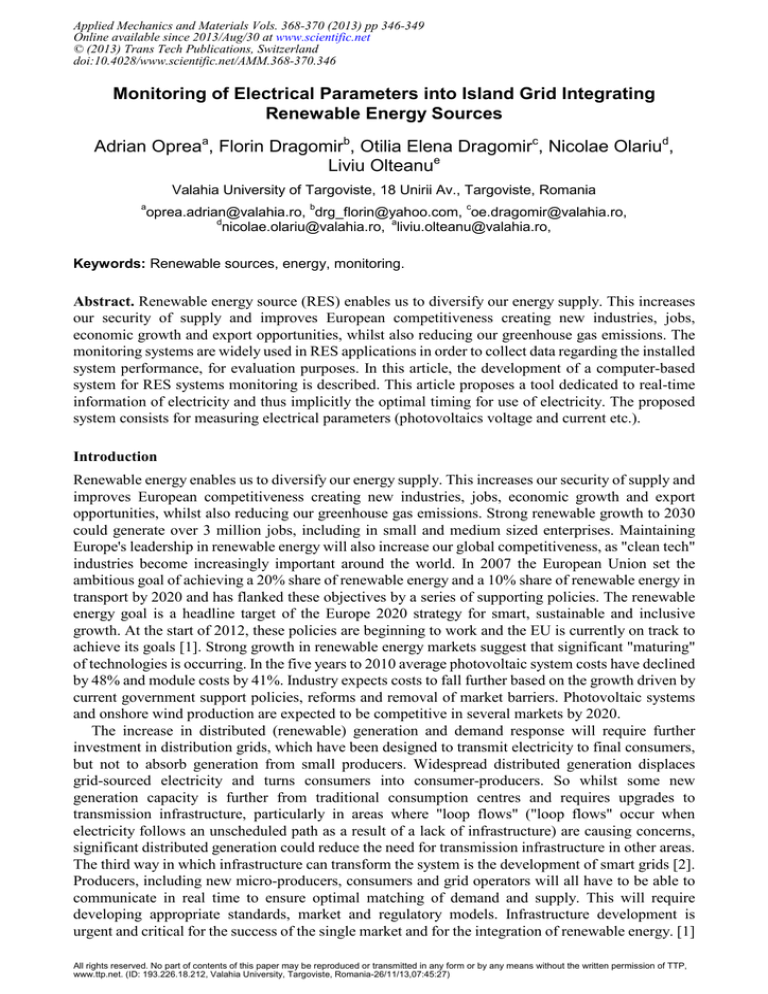
Applied Mechanics and Materials Vols. 368-370 (2013) pp 346-349
Online available since 2013/Aug/30 at www.scientific.net
© (2013) Trans Tech Publications, Switzerland
doi:10.4028/www.scientific.net/AMM.368-370.346
Monitoring of Electrical Parameters into Island Grid Integrating
Renewable Energy Sources
Adrian Opreaa, Florin Dragomirb, Otilia Elena Dragomirc, Nicolae Olariud,
Liviu Olteanue
Valahia University of Targoviste, 18 Unirii Av., Targoviste, Romania
a
oprea.adrian@valahia.ro, bdrg_florin@yahoo.com, coe.dragomir@valahia.ro,
d
nicolae.olariu@valahia.ro, aliviu.olteanu@valahia.ro,
Keywords: Renewable sources, energy, monitoring.
Abstract. Renewable energy source (RES) enables us to diversify our energy supply. This increases
our security of supply and improves European competitiveness creating new industries, jobs,
economic growth and export opportunities, whilst also reducing our greenhouse gas emissions. The
monitoring systems are widely used in RES applications in order to collect data regarding the installed
system performance, for evaluation purposes. In this article, the development of a computer-based
system for RES systems monitoring is described. This article proposes a tool dedicated to real-time
information of electricity and thus implicitly the optimal timing for use of electricity. The proposed
system consists for measuring electrical parameters (photovoltaics voltage and current etc.).
Introduction
Renewable energy enables us to diversify our energy supply. This increases our security of supply and
improves European competitiveness creating new industries, jobs, economic growth and export
opportunities, whilst also reducing our greenhouse gas emissions. Strong renewable growth to 2030
could generate over 3 million jobs, including in small and medium sized enterprises. Maintaining
Europe's leadership in renewable energy will also increase our global competitiveness, as "clean tech"
industries become increasingly important around the world. In 2007 the European Union set the
ambitious goal of achieving a 20% share of renewable energy and a 10% share of renewable energy in
transport by 2020 and has flanked these objectives by a series of supporting policies. The renewable
energy goal is a headline target of the Europe 2020 strategy for smart, sustainable and inclusive
growth. At the start of 2012, these policies are beginning to work and the EU is currently on track to
achieve its goals [1]. Strong growth in renewable energy markets suggest that significant "maturing"
of technologies is occurring. In the five years to 2010 average photovoltaic system costs have declined
by 48% and module costs by 41%. Industry expects costs to fall further based on the growth driven by
current government support policies, reforms and removal of market barriers. Photovoltaic systems
and onshore wind production are expected to be competitive in several markets by 2020.
The increase in distributed (renewable) generation and demand response will require further
investment in distribution grids, which have been designed to transmit electricity to final consumers,
but not to absorb generation from small producers. Widespread distributed generation displaces
grid-sourced electricity and turns consumers into consumer-producers. So whilst some new
generation capacity is further from traditional consumption centres and requires upgrades to
transmission infrastructure, particularly in areas where "loop flows" ("loop flows" occur when
electricity follows an unscheduled path as a result of a lack of infrastructure) are causing concerns,
significant distributed generation could reduce the need for transmission infrastructure in other areas.
The third way in which infrastructure can transform the system is the development of smart grids [2].
Producers, including new micro-producers, consumers and grid operators will all have to be able to
communicate in real time to ensure optimal matching of demand and supply. This will require
developing appropriate standards, market and regulatory models. Infrastructure development is
urgent and critical for the success of the single market and for the integration of renewable energy. [1]
All rights reserved. No part of contents of this paper may be reproduced or transmitted in any form or by any means without the written permission of TTP,
www.ttp.net. (ID: 193.226.18.212, Valahia University, Targoviste, Romania-26/11/13,07:45:27)
Applied Mechanics and Materials Vols. 368-370
347
Modular Power Plant
The article proposes a tool dedicated to real-time information of electricity and thus implicitly the
optimal timing for use of electricity.
The structure of such platforms in terms of energy is the following:
(a)
(b)
Fig. 1. (a) Block structure of the system; (b) Connection scheme for electricity generation system on
the AC network.
Modules of the platform structure characteristics are:
• photovoltaic panels (24 panels distributed in two substrings);
• inverter (Sunny Boy 2100TL)
• data logger (Sunny Boy Control)
• computer (with software Sunny Data Control)
• radiation sensor (Kipp&Zonen CM21)
• data logger (Kipp&Zonen)
The photovoltaic panels are type PV ST40 by Siemens and these modules are connected according
to the diagram in Fig. 1 (a), the Sunny Boy inverter with powers between 700W and 2100W.
The system consists of two substrings photovoltaic panels turn connected through the inverter to
AC power.
Table 1. Characteristics PV panels
Model
Producer
PV ST40
Siemens
Nr.
buc.
24
Characteristics (per modul)
Vmax
Imax
Voc
46V
4,8A
58V
Pmax
220W
where: Pmax = Nominal Maximum Output Power
Vmax = Nominal Maximum Output Voltage
Imax = Nominal Maximum Output Current
Isc
5,33A
Voc = Nominal Open Circuit Voltage
Isc = Nominal Short Circuit Current
Solar generating stations needed to make the separate inverters DC to AC produced for network.
The system is single phase AC. Sunny Family inverters range, SMA products, offers excellent
possibilities for creating a network of independent, because of their flexibility. Powered by renewable
energy sources and connected to a battery, they form a network independent.
Inverter used between photovoltaic panels and the network AC is the type SB2100TL Sunny Boy,
and is the ideal choice for photovoltaic installations because the input is up to 600V. SB2100TL
inverter characteristics are presented in Table 2.
Table 2. Characteristics inverter SB2100TL
Input (DC)
Output (AC)
Max. DC input power
2200 W
Nominal AC output power
1950 W
Max. DC voltage
600 V
Max. AC output power
2100 W
PV voltage range, MPPT
200 V - 480 V
Max. output current
11 A
Max. input current
11 A
Nominal AC voltage / range
220 V - 240 V / 180 V - 260 V
Number of MPP trackers
1
AC grid frequency / range
50 Hz / ±4.5 Hz
Max. number of strings (parallel)
2
Power factor (cos ϕ)
1
AC connection
single-phase
Efficiency
Max. efficiency
96.0 %
Euro ETA
95.2 %
348
Frontiers of Green Building, Materials and Civil Engineering III
Sunny Boy Inverters SB2100TL can be mounted parallel to two modules, diagnosis and
communication can be done through normal electrical grid or a RS485 connection.
Connection diagram (Fig. 1 (b)) was made based on the properties panel (short-circuit current, load
voltage). With an efficiency level of 96 % the transformer less Sunny Boy 2100TL guarantees
first-class energy yields and thus an outstanding price/performance ratio. The tried and tested inverter
is particularly suitable for use in small PV systems as well as in sub generators in larger systems. Its
low weight and robust housing enable easy installation. The integrated DC load-disconnecting switch
saves the system operator the cost of an external switching device. In addition, the Sunny Boy 2100TL
is equipped with an all-pole sensitive leakage current monitoring unit, which guarantees safe
operation at all times. As with all Sunny Boys, the Sunny Boy 2100TL is also compatible with SMA
communication products.
Sunny Boy Inverters SB2100TL can be mounted parallel to two modules, diagnosis and
communication can be done through normal electrical grid or a RS485 connection.
The Sunny Boy Control collects detailed data from your PV system, enabling you to monitor
system operation and performance any time.
Sunny Data Control is the ideal addition for system monitoring with Sunny Boy Control and a PC.
The free software archives the data from the data logger long-term on the PC, evaluates and presents it
visually on the monitor. A further advantage: Sunny Data Control can be configured to directly
communicate with your inverter and a PC. Thus it is possible to set your system's parameters without
a data logger.
The CM21 pyranometer is designed for measuring the irradiance (radiant-flux, Watt/m2) on a
plane surface, which results from the direct solar radiation and from the diffuse radiation incident
from the hemisphere above. CM21 is a high precision pyranometer with strictly selected domes.
Because of the high optical quality of these domes the directional error is reduced to less than 10
W/m2.
Experimental Result
Fig. 3 and Fig. 4 presents data monitored by Sunny Data Control. Period the monitoring is one day
(02.07.2012) and four days (02.07.2012-05.07.2012). Graphic data were acquired every 10 minutes.
(a)
(b)
(c)
(d)
(e)
(f)
(g)
(h)
Fig.3. Monitored data graphs on 02.07.2012; (a) Voltage Upv; (b) Current Ipv; (c) Voltage Uac; (d)
Current Iac; (e) Power Pac; (f) Energy total; (g) Frequency Fac; (h) Impedance Zac
Applied Mechanics and Materials Vols. 368-370
(a)
349
(b)
Fig.4. Graphs data monitored during 02.07.2012-05.07.2012; (a) Power Pac; (b) Energy total
The analysis of these data we can draw conclusions about the functioning of the whole system,
while preserving the performance of photovoltaic conversion, the factors involved in the proper
functioning (the panels significantly dusty, heavy snow falls, state boards cells), return and
conversion efficiency [3].
Conclusion and Acknowledgements
The monitoring system is used in RES systems in order to collect data regarding the system
performance for evaluation purposes. Most present monitoring systems collect the data of interest and
store them in a local memory until the system operator downloads them to a computer. In this article,
is presented the development of an integrated computer-based monitoring system for RES plants is
described. The proposed method is based on components easy-to-use for processing, displaying and
storing the collected data. The system operator can easily process the measured parameters using any
functions available. The proposed architecture has the advantages of rapid development and
flexibility in the case of changes, while it can be easily extended for controlling the RES system
operation.
This work was supported by a grant of the Romanian National Authority for Scientific Research,
CNDI– UEFISCDI, project code PN-II-PT-PCCA-2011-3.2-1616.
References
[1] Communication from the Commission to the European Parliament, the Council, the European
Economic and Social Committee and the Committee of the Regions, Renewable Energy: a major
player in the European energy market, http://eur-lex.europa.eu/LexUriServ/LexUriServ.do?uri=
CELEX:52012DC0271:EN:NOT and
[2] Communication from the Commission to the European Parliament, the Council, the European
Economic and Social Committee and the committee of the regions, Smart Grids: from innovation
to deployment, http://eur-lex.europa.eu/LexUriServ/LexUriServ.do?uri=COM:2011:0202:FIN
:EN:PDF
[3] F. Dragomir, O.E. Dragomir, E. Minca, Adaptive control access of stand-alone power systems,
Book Series: Energy Procedia, Volume: 14, Pages: 552-557, 2012
Frontiers of Green Building, Materials and Civil Engineering III
10.4028/www.scientific.net/AMM.368-370
Monitoring of Electrical Parameters into Island Grid Integrating Renewable Energy Sources
10.4028/www.scientific.net/AMM.368-370.346





